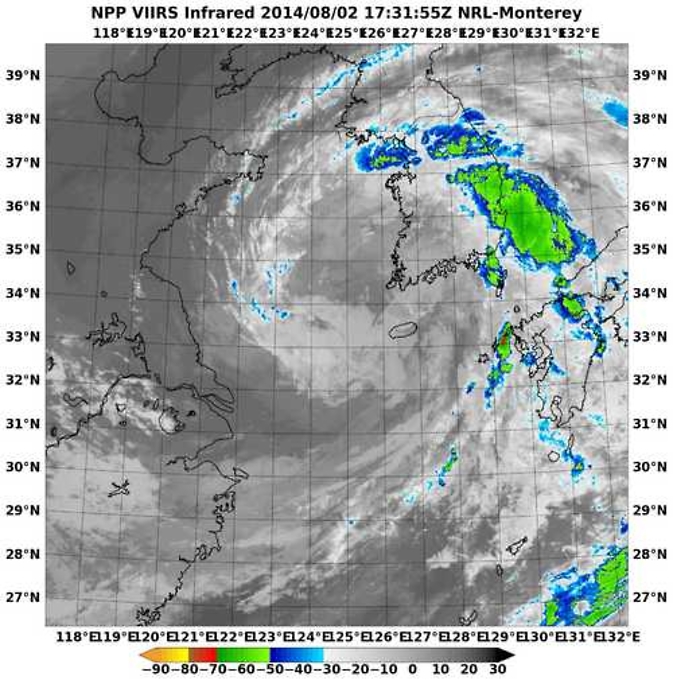NASA Catches the Brief Life of Tropical Storm Nakri

This infrared image of Tropical Storm Nakri was taken from the VIIRS instrument aboard NASA-NOAA's Suomi NPP satellite on Aug.2. VIIRS showed the heaviest precipitation was falling east of the center of circulation. Image Credit: NASA/NOAA
On Saturday, August 2, at 9 p.m. EDT, Nakri's maximum sustained winds were near 40 knots (46 mph/74 kph).
At that time it was centered about 100 nautical miles southeast of Kunsan Air Base, near 35.0 north and 125.0 east. It was moving to the north at 14 knots (16.1 mph/21.9 kph).
When NASA-NOAA's Suomi NPP satellite passed over Nakri on August 2, the Visible Infrared Imaging Radiometer Suite (VIIRS) instrument aboard captured an infrared image of the storm.
The VIIRS instrument showed a tightly wrapped center with fragmented bands of thunderstorms wrapping into the center. VIIRS also showed the heaviest precipitation was falling east of the center of circulation.
VIIRS collects visible and infrared imagery and global observations of land, atmosphere, cryosphere and oceans. VIIRS flies aboard the Suomi NPP satellite, which is managed by both NASA and NOAA.
By 1900 UTC (5 p.m. EDT) on August 3, the Joint Typhoon Warning Center issued its final advisory on Nakri. By that time, Nakri had already weakened to a tropical depression.
It was centered near 36.1 north and 125.8 east, about 15 nautical miles (17.2 miles/27.8 km) northwest of Kunsan Air Base. Later on August 3, Nakri dissipated on approach to the Korean peninsula.
Text credit: Rob Gutro
NASA's Goddard Space Flight Center
Media Contact
More Information:
http://www.nasa.gov/content/goddard/nakri-northwestern-pacific-ocean/All latest news from the category: Earth Sciences
Earth Sciences (also referred to as Geosciences), which deals with basic issues surrounding our planet, plays a vital role in the area of energy and raw materials supply.
Earth Sciences comprises subjects such as geology, geography, geological informatics, paleontology, mineralogy, petrography, crystallography, geophysics, geodesy, glaciology, cartography, photogrammetry, meteorology and seismology, early-warning systems, earthquake research and polar research.
Newest articles

Making diamonds at ambient pressure
Scientists develop novel liquid metal alloy system to synthesize diamond under moderate conditions. Did you know that 99% of synthetic diamonds are currently produced using high-pressure and high-temperature (HPHT) methods?[2]…

Eruption of mega-magnetic star lights up nearby galaxy
Thanks to ESA satellites, an international team including UNIGE researchers has detected a giant eruption coming from a magnetar, an extremely magnetic neutron star. While ESA’s satellite INTEGRAL was observing…

Solving the riddle of the sphingolipids in coronary artery disease
Weill Cornell Medicine investigators have uncovered a way to unleash in blood vessels the protective effects of a type of fat-related molecule known as a sphingolipid, suggesting a promising new…





















